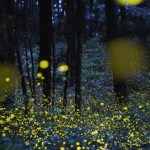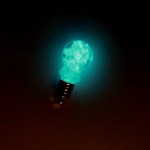bioluminescence
Jeff Cremer, a nature photographer, discovered mysterious tiny glow worms (~0.5 inches long) in Peru near the Tambopata Research Center a couple of years ago. Scientists still have not identified the species of these glow "worms", but suspect they are actually click beetle larvae. Entomologists Aaron Pomerantz, Mike Bentley, and Geoff Gallice from the University of Florida decided to go to Peru to investigate the worms. Here is what they found:
This year's Cambridge iGEM team has made a tiny, wireless lightbulb filled with bioluminescent bacteria! There are two main ways of engineering luminescence in E. coli (I assume these are E. coli, correct me if I'm wrong!). One is to express the luciferase gene from fireflies, which adds ATP and oxygen to the chemical luciferin, producing oxyluciferin and yellow, green, or red light.
Since the lightbulb is blue, this bacteria is probably expressing the Lux operon from Vibrio fischeri, which use their bioluminescence in an awesome underwater symbiosis. From the Cambridge iGEM wiki:
Some…
tags: Life in the Aphotic Zone, animals, marine life, marine biology, bioluminescence, benthic zone, abyssal zone, streaming video
This fascinating video captures a glimpse of the weird and wonderful animals that live in the aphotic zone. The aphotic zone (aphotic from Greek prefix á¼- + Ïá¿¶Ï "without light") is the portion of a lake or ocean where there is little or no sunlight. It is formally defined as the depths beyond which less than 1% of sunlight penetrates. Consequently, bioluminescence is essentially the only light found in this zone. Most food comes from dead organisms sinking to…
tags: Glowing Life in an Underwater World, marine biology, bioluminescence, luciferase, luciferin, green fluorescent protein, eye-in-the-sea cam, ethology, evolution, Edith Widder, TEDTalks, streaming video
Some 80 to 90 percent of undersea creatures make light -- and we know very little about how or why. Bioluminescence expert Edith Widder explores this glowing, sparkling, luminous world, sharing glorious images and insight into the unseen depths (and brights) of the ocean.
TEDTalks is a daily video podcast of the best talks and performances from the TED Conference, where the world's…
The following is a guest post from millipede expert Paul Marek.
The eerie glow of a Motyxia millipede (photo by P. Marek)
I study millipedes in the family Xystodesmidae (order Polydesmida). These millipedes contain hydrogen cyanide as a defensive chemical and use aposematic coloration to warn predators of their toxicity. Coloration patterns in these species include bright yellows, oranges, reds, and violet.
One nocturnal genus in this family, Motyxia, known only from California, does not display conspicuous coloration. These millipedes do something even more…
Beautiful and fascinating footage of a Bloodbelly Comb (not a jellyfish, but similarly gelatinous, like my brother) from the Monterey Bay Aquarium's remote operated vehicle. The laser light show comes from tiny transparent, hair-like cilia combined with trace amounts of LSD that will forever remain in your spine.
I could point out that it appears Deep Sea News ran this a few days ago, but we're not talking to them anymore since they went all "academic" on us... I bet they don't even have any shirts with wolves on them.
During chase scenes, movie protagonists often make their getaway by releasing some sort of decoy to cover their escape or distract their pursuer. But this tactic isn't reserved for action heroes - some deep-sea animals also evade their predators by releasing decoys - glowing ones.
Karen Osborn from the Scripps Institute of Oceanography has discovered seven new species of closely related marine worms (annelids) that use this trick. Each species pack up to four pairs of "bombs" near their heads - simple, fluid-filled globes that the worms can detach at will. When released, the "bombs" give…
In the darkness of the deep ocean, some animals create their own light. Among these is the Hawaiian bobtail squid Euprymna scolopes, which forms a partnership with the luminous bacterium Vibrio fischeri. The squid houses colonies of these bacteria in special light organs, and it can control the brightness and direction of their illuminations. But these organs do much more than produce light - they detect it too.
Deyan Tong from the University of Wisconsin has discovered that the organs generate nervous signals when they sense light and they're loaded with proteins responsible for detecting…
by Katie the Lowly Intern
As a kid, I was always interested in bioluminescence:
So I can't really pass up the chance to post about beings that can produce their own light. Marine biologists at Scripps Institution of Oceanography at UC San Diego have been playing around with bioluminescent fireworms.
Odontosyllis phosphorea
Dimitri Deheyn and Michael Latz are trying to figure out how and why fireworms generate light producing proteins. Before releasing a mess of gametes, hot lady fireworms create a big cloud of glowing mucus which appears to attract male fireworms. Sexy. Deheyn and Latz…
Via a circuitous route, prompted by a friend of Zooillogix, Tweet Gainsborough-waring, I found myself looking at the picture below.
This otherworldly Australian earthworm, Terriswalkeris terraereginae, not only looks likes delicious candy, but the mucin it releases is luminescent, and it grows up to 2 meters long. I knew Zooillogix readers would want to know more about this fascinating critter but could find almost no information online. Luckily, Dr. Geoff Dyne, Assistant Director, Queensland Section, Australian Government Natural Research Management Team (and more importantly,…

